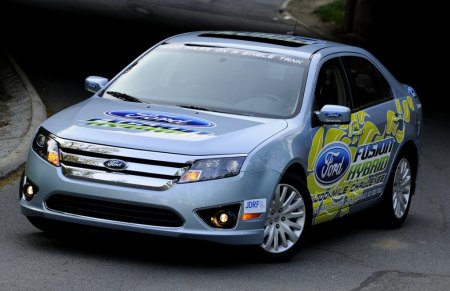Ford Fusion Hybrid does 2313 km on one tank

While Ford Middle East still peddles leftover four-banger versions of the 2009 Ford Fusion in the GCC, the redesigned 2010 Ford Fusion Hybrid is making waves in the United States. Drivers trained in mileage-maximizing techniques were able to get an extraordinary 2313 km out of a single tank of petrol during a fund-raising road-trip and publicity stunt. They did it by averaging 2.88 litres per 100 km, using a non-modified Fusion Hybrid straight off the showroom floor. The Fusion Hybrid already calls itself the most fuel-efficient midsize sedan in North America.
The “Fusion Hybrid Challenge” started at 8:15 am on April 25 and ended at 5:37 am in Washington DC. The goal was to surpass 1600 km, but after more than 69 continuous hours of driving, the Fusion Hybrid finally depleted its tank and came to a stop with an odometre reading of 2313 km, setting a world record for gasoline-powered, midsize sedan.
The challenge team, which included NASCAR driver Carl Edwards, high mileage expert Wayne Gerdes and several Ford Motor Company engineers, raised more than $8,000 for the Juvenile Diabetes Research Foundation.
The route involved elevation changes, and ranged from open roads to a 5 km stretch in the heart of the city that is clogged with roughly 30 traffic signals.
A team of seven drivers prepared for the challenge by learning a few mileage-maximizing techniques, most of which can be used in any vehicle to improve fuel economy, but are especially useful in the Fusion Hybrid where the driver can take advantage of pure electric energy at speeds below 75 kph.
Wayne Gerdes, an engineer, coined the term “hypermiling” to describe mileage-maximizing techniques, some of which are obvious to smarter people, and some which are too complicated to follow with a non-hybrid car. They include:
- Slowing down and maintaining even throttle pressure.
- Gradually accelerating and smoothly braking.
- Maintaining a safe distance between cars to allow time for anticipating traffic conditions.
- Rolling up slowly to red lights and stop signs to avoid fuel waste and brake wear.
- Minimize use of heater and air conditioning to reduce the load on the engine.
- Close windows at high speeds to reduce aerodynamic drag
- Minimize excessive engine workload by using the vehicle’s kinetic forward motion to climb hills, and use downhill momentum to build speed.
- Avoiding bumps and potholes that can reduce momentum
- Applying the “Pulse and Glide” technique while maintaining the flow of traffic.
That last point, about the “Pulse and Glide” technique, was something new, so we looked it up. Basically, we’ve always known that cruising along at, say, a constant 80 kph is the most efficient way to save fuel on the highway. However, pulse-and-glide involves very slowly accelerating up to 90 kph, then slipping into neutral and turning off the engine, and letting the car slowly float down to 70 kph by itself. At this point, the engine is started and the car is slowly brought up to 90 kph, and the process is repeated for as long as the driver doesn’t get bored of it.
Independent tests have proved that this actually saves more fuel. Even just slipping into neutral and idling, instead of turning off the engine, saves a bit more fuel than simply maintaining a constant speed. Of course, this takes a toll on a normal car’s starter system, but all hybrids come with an automatic engine start-stop feature, which makes it much easier to follow the pulse-glide technique, provided the acceleration phase is done slowly, in as long as 15 to 20 seconds.

Comments
Faisal
impressive numbers!!!
vivek
hmm…sexy car with sexy numbers..tatz sexy !!! 😉
xyz
Hey mash did da new e-class launch in uae???? it launched here in ksa
Mashfique Hussain Chowdhury
ya, there was an e-class launch event here. except the merc PR guy was disrespecting me, so i refused to go.
Moh'd
The Fusion is a very good car and is no less capable than the highly regarded Accord, Altima, and Camry. The handling of this car is regarded better than the Accord and the Camry, but slightly shy of beating the Altima.
The 2010 model gets an upgraded engine from 2.3 to 2.5 litres with more horse power (from 160hp to 175hp), and yet with a better fuel economy. In fact, it’s more fuel efficient than the other three top Japanese cars. Interesting fact is that one full tank of 66 litres can drive you up to 800 highway klms; that’s an impressive 8.25 litres per 100 klm for a 175 hp mid-size sedan!!!
I think it’s obvious that I am getting me one of those next year.